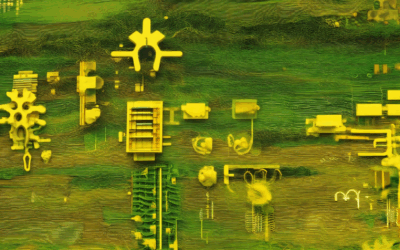In today’s fast-paced digital landscape, businesses are increasingly recognizing the importance of adopting sustainable digital solutions to minimize their environmental footprint and maximize long-term success. As consumers become more environmentally conscious, companies are under pressure to redefine their approach to innovation and technology, prioritizing projects that not only drive growth but also contribute positively to the environment. By embracing sustainable practices, organizations can not only reduce their ecological impact but also improve their competitiveness, foster a positive reputation, and stay ahead in the market.

Sustainable Digital Solutions
We believe that sustainable digital solutions are crucial for a better future.
- At Iterati, we’re committed to helping businesses and individuals adopt environmentally friendly and socially responsible digital practices.
- Sustainable digitalization involves designing and developing technologies that minimize harm to the environment and promote social equity.
- This approach requires considering the entire lifecycle of a product or service, from production to disposal or recycling.
Key Principles of Sustainable Digital Solutions
- Eco-Friendliness: Reduce electronic waste, energy consumption, and carbon emissions associated with digital products and services.
- Social Responsibility: Promote fair labor practices, accessibility, and inclusivity in digital product development and deployment.
- Transparency: Provide clear information about digital products and services, including their environmental and social impact.
- Accountability: Encourage companies to take responsibility for the environmental and social consequences of their digital activities.
Examples of Sustainable Digital Solutions
- Clean Energy: Invest in renewable energy sources, such as solar or wind power, to reduce dependence on fossil fuels.
- Energy-Efficient Data Centers: Implement efficient cooling systems, use recycled water, and optimize server usage to minimize energy consumption.
- Electronic Waste Management: Develop programs for responsible e-waste disposal, recycling, and reuse.
- Digital Accessibility: Design products and services that are accessible to people with disabilities, promoting equal opportunities and social inclusion.
Benefits of Sustainable Digital Solutions
- Reduced Environmental Impact: Minimize pollution, conserve resources, and mitigate climate change.
- Improved Social Equity: Promote fair labor practices, accessibility, and inclusivity, contributing to a more equitable society.
- Increased Efficiency: Optimize resource usage, reduce waste, and enhance productivity through sustainable digital practices.
- Competitive Advantage: Demonstrate leadership and commitment to sustainability, attracting customers, investors, and top talent.
Getting Started with Sustainable Digital Solutions
At Iterati, we offer resources and expertise to help you embark on your sustainable digital journey.
- Assess your current digital footprint and identify areas for improvement.
- Set realistic goals and develop a roadmap for implementing sustainable digital practices.
- Prioritize eco-friendliness, social responsibility, transparency, and accountability in your decision-making process.
- Engage stakeholders, including employees, customers, and suppliers, to foster a culture of sustainability.
Example of Digital Sustainability
Digital sustainability refers to the responsible management and use of digital technologies to minimize their environmental impact.
-
Green Data Centers
Building and operating data centers with a focus on sustainability, such as using renewable energy sources, improving cooling systems, and adopting energy-efficient hardware, is a critical component of digital sustainability.
-
Sustainable IT Infrastructure
Implementing sustainable IT infrastructure involves using energy-efficient servers, storage systems, and networking equipment, as well as designing data centers to optimize energy consumption and reduce waste.
-
E-Waste Management
Electronic waste (e-waste) management is essential for reducing the environmental impact of digital technologies. This includes responsible disposal and recycling of electronic devices, as well as implementing take-back programs for end-of-life products.
-
Circular Economy Practices
Circular economy practices involve designing digital products and services to be restorative and regenerative by design, aiming to keep materials in use for as long as possible and extracting the maximum value from them.
-
Education and Awareness
Raising awareness among employees, customers, and stakeholders about the importance of digital sustainability is crucial for driving behavior change and promoting sustainable practices within organizations.
By incorporating these principles into our daily operations, we can reduce the environmental footprint of digital technologies and promote a more sustainable future.

What Are Sustainable Technology Solutions?
The goal of sustainable technology is twofold: to produce new technologies using sustainable processes and materials, and to use technologies to address environmental, social, and governance (ESG) issues.
- We believe that sustainable technology solutions can have a profound impact on our planet and its inhabitants. At Iterati, we’re committed to empowering individuals and organizations to adopt innovative and environmentally responsible practices.
- Sustainable technology encompasses a broad range of fields, including renewable energy, green infrastructure, eco-friendly products, and circular economy initiatives.
Key Areas of Focus:
-
Renewable Energy:
- Investing in solar, wind, hydro, and geothermal power to reduce dependence on fossil fuels.
- Developing smart grids and energy storage systems to optimize energy distribution and consumption.
-
Green Infrastructure:
- Designing and implementing sustainable buildings, transportation systems, and urban planning strategies.
- Creating green spaces and parks to mitigate the urban heat island effect and promote biodiversity.
-
Eco-Friendly Products:
- Developing products made from recycled materials, bioplastics, and sustainably sourced raw materials.
- Implementing product-as-a-service models to reduce waste and encourage sharing economies.
-
Circular Economy Initiatives:
- Designing products and services that are restorative and regenerative by design.
- Encouraging sharing, leasing, and product take-back programs to minimize waste and maximize resource efficiency.
Competitors and Industry Leaders:
While there are many companies working towards sustainable technology solutions, some notable players in the field include:
- Siemens: A global leader in electrification, automation, and digitalization, Siemens is committed to reducing its carbon footprint and promoting sustainable development.
- Microsoft: Through its sustainability initiative, Microsoft aims to reduce its greenhouse gas emissions and promote environmentally responsible practices among its customers and partners.
- Google: Google’s commitment to sustainability includes investing in renewable energy, reducing energy consumption, and promoting eco-friendly practices in its operations and supply chain.
Best Practices for Implementing Sustainable Technology Solutions:
To get started on your sustainable technology journey, consider the following best practices:
- Conduct a thorough assessment of your organization’s environmental impact and identify areas for improvement.
- Set ambitious sustainability goals and develop a roadmap for achieving them.
- Invest in renewable energy and energy-efficient technologies to reduce your carbon footprint.
- Implement sustainable procurement practices and source materials from suppliers who share your values.
- Engage your employees, customers, and stakeholders in your sustainability efforts and encourage their participation in reducing waste and conserving resources.

Sustainable Solutions
We’re committed to empowering our community with innovative ideas and practical strategies for a more sustainable future.
-
Renewable Energy
Investing in renewable energy sources like solar and wind power can significantly reduce our carbon footprint and reliance on fossil fuels.
- Implementing energy-efficient technologies in our daily lives, such as LED light bulbs and smart thermostats, can also contribute to a more sustainable environment.
- Supporting companies that prioritize renewable energy and sustainable practices can drive positive change and promote eco-friendly innovations.
-
Sustainable Infrastructure
Developing sustainable infrastructure, such as green buildings and public transportation systems, can have a lasting impact on reducing waste and emissions.
- Designing cities with walkability, bikeability, and accessible public transportation can encourage a reduction in private vehicle usage and promote a healthier lifestyle.
- Incorporating green roofs, rain gardens, and other eco-friendly features into urban planning can mitigate the effects of climate change and improve air quality.
-
Circular Economy
Fostering a circular economy by promoting recycling, reusing, and reducing waste can minimize environmental degradation and support sustainable development.
- Implementing extended producer responsibility, where manufacturers take ownership of their products’ waste, can encourage companies to design more sustainable packaging and products.
- Encouraging sharing economies, product-as-a-service models, and collaborative consumption can reduce waste and promote resource efficiency.
-
Climate Resilience
Building climate resilience through adaptation and mitigation strategies can protect communities from the impacts of climate change.
- Investing in early warning systems, emergency preparedness plans, and climate-resilient infrastructure can save lives and reduce economic losses.
- Supporting climate-smart agriculture, conservation efforts, and ecosystem-based adaptation initiatives can enhance biodiversity and promote ecological balance.
By embracing these sustainable solutions, we can work together towards a brighter, more environmentally conscious future.
Sustainable Development Examples
I’m excited to share with you four examples of sustainable development that I believe have the potential to transform our world.
-
Renewable Energy Transition
The transition to renewable energy sources is a crucial step towards achieving sustainable development. By investing in solar, wind, and hydroelectric power, we can reduce our reliance on fossil fuels and mitigate climate change. Companies like Tesla and Vestas are leading the charge in this space, making renewable energy more accessible and affordable for communities around the world.
-
Circular Economy Practices
A circular economy is an economic model that aims to reduce waste and promote the reuse and recycling of materials. This approach has numerous benefits, including reducing greenhouse gas emissions, conserving natural resources, and creating new job opportunities. Companies like Patagonia and H&M are already implementing circular economy practices in their supply chains, reducing waste and promoting sustainability.
-
Sustainable Agriculture Methods
Sustainable agriculture methods involve farming practices that prioritize soil health, biodiversity, and efficient water use. These approaches not only promote environmental sustainability but also improve crop yields and enhance food security. Organizations like the Rodale Institute and the World Wildlife Fund are working with farmers to adopt sustainable agriculture methods, promoting a healthier planet for future generations.
-
Green Infrastructure Development
Green infrastructure refers to the use of natural systems to manage urban stormwater runoff, mitigate the urban heat island effect, and improve air quality. Cities like New York and Chicago are investing in green roofs, parks, and green spaces to create more livable and sustainable environments. These initiatives not only benefit local ecosystems but also contribute to a healthier and more resilient community.

Understanding Sustainable Solutions
Sustainable solutions refer to approaches, methods, or technologies that help minimize harm to the environment, conserve natural resources, and promote social equity.
- They aim to reduce waste, emissions, and pollution, while increasing efficiency and productivity.
- Sustainable solutions often involve the use of renewable energy sources, such as solar and wind power, and the adoption of circular economy principles.
- They also prioritize the well-being of people and communities, addressing issues like poverty, inequality, and access to education and healthcare.
Key Characteristics of Sustainable Solutions
Sustainable solutions typically exhibit several key characteristics:
- Long-term thinking and planning
- Integration of environmental, social, and economic considerations
- Adoption of innovative and efficient technologies
- Collaboration and stakeholder engagement
Examples of Sustainable Solutions
Some examples of sustainable solutions include:
- Renewable energy systems, such as solar panels and wind turbines
- Energy-efficient buildings and green architecture
- Electric vehicles and public transportation systems
- Organic farming and permaculture practices
Benefits of Sustainable Solutions
The benefits of sustainable solutions are numerous and far-reaching:
- Reduced greenhouse gas emissions and climate change mitigation
- Conservation of natural resources and reduction of waste
- Improved air and water quality
- Creation of jobs and economic opportunities in the clean energy sector
Conclusion
In conclusion, sustainable solutions are essential for creating a more equitable, prosperous, and environmentally conscious world.
By adopting sustainable solutions, we can reduce our impact on the planet, improve human well-being, and drive economic growth.
As individuals, businesses, and governments, we must work together to develop and implement sustainable solutions that benefit both people and the planet.




0 Comments